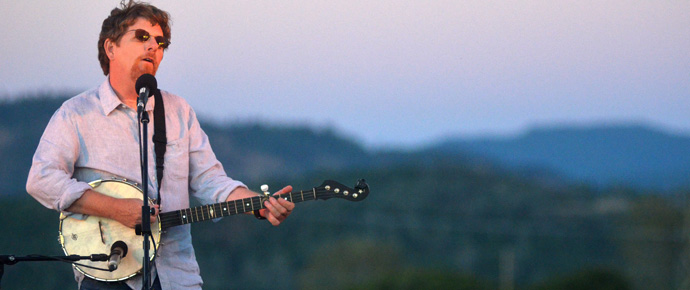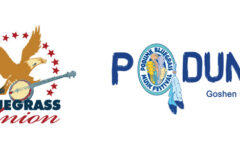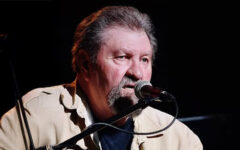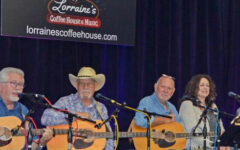
This interview was conducted in February 2018. It was meant to be the first episode of a new radio show focused on the craft of songwriting that never panned out. Tim O’Brien is a great hero of mine, and a friend, and he imparted some wonderful stories and wisdom in our conversation. It was too good to leave sitting on my computer and the current pandemic allowed me some unexpected time to transcribe it. The interview has been lightly edited for clarity.
–Randy Barrett
RB: According to lore, you wrote a note to your mom when you dropped out of college and it said something like: “I’m heading west. I know 200 songs now and I figure if I keep learning more, I should be all right.” Is that true?
TO: [Laughs] I think that’s pretty much true. That’s her quote but I probably said something pretty much to that effect. I probably said if I could make $25 I could live for the week. I remember when Hot Rize started, $100 would keep us going – $100 a week, per member. So I think on my own, starting a couple of years before that, I was like, yeah, if could get $45 a week or something I could not have to ask my parents for money and I could keep playing music and I might get better at it.
RB: At what point did you go from learning 200-plus songs to songwriting?
TO: Well, Hot Rize was a catalyst. I’d already been dabbling in it and never thought much about it. And then when Hot Rize started, everybody said it’s a good value if you write your own songs. So that was the idea and Pete Wernick had done it and I figured maybe I could too. So Nick and I and Pete all put our pens to paper separately and as collaborators. We wrote songs and then I found that people liked them so we recorded them. It’s a carrot at the end of the stick. It encourages you to keep doing it again.
RB: The first of Tim O’Brien song I became aware of, which is one of your greats, is Nellie Kane. Tell me how that came about.
TO: We had some original songs for our first Hot Rize record and right before we went into the studio I came up with this one. They were a little bit reluctant to try it right away but they kind of liked it so we did it. One of my favorite movies growing up was called Shane, a western. The protagonist is this drifter guy who hires on with a family on a little farm and he helps them make it through the winter but the father figure has deserted them. So Shane becomes the father to the kid and after the whole plot goes through and credits are rolling, he’s back with the family and he has the girl and everything is groovy. Meanwhile, my friend Nugget, (Mike Kemnitzer, who makes mandolins) had an adopted his wife’s son – and so I thought of him and I liked Shane and so I kind of made something up out of that [laughs].
RB: Hot Rize is a natural place for your material. There are so many great songs that you all did, like Sweetest Song I Sing, Walk the Way the Wind Blows, Late in the Day, Untold Stories. Was there ever a song that you brought to the band that just crashed and burned?
TO: Oh yeah. I’m still trying to pitch this same song over and over to them. [Laughs]. I won’t say what it is.
RB: So they all look at you with straight faces and say, “Let’s go to lunch” or something?
TO: It’s kind of like that. If you’re an artist, you have to learn when people say no to just let it roll off. A lot of times, there is a reason, so you ask yourself what it is. And if you can’t find the reason and you still believe in it — I go by instinct. I still believe in this particular song so I keep pitching it to them [laughs]. Pete did the same thing with Just Like You. He pitched that to us when we’d been together a couple of years and we tried it and worked it up in a couple of keys and tried it with different arrangements, and it was just really hard and we never went back to it. Then, years later, we really needed material and I said let’s have another look at it and it turned out to be a really good idea.
RB: Talk to me about your process. Are you a keep-a-notebook-full-of-notes guy? Or are you a things-float-into-your-head guy?
TO: I’ve got piles of little notebooks that fit in your shirt pocket. They’ve got notes about everything that goes on in my life that I need when I’m driving. Feathered in there are little lyric ideas. I just wrote three pages on the way home from Boston on Monday morning. I was very sleep deprived and I was reading this book and I was turned on by it, so I started writing. I’ve got to take a look at that. But that notebook may end up discarded in a pile somewhere until I know I need new songs to record. I’m kind of a deadline guy but I’m always inputing – taking things into my mind and sometimes writing notes on it. More often than not there’s a little phrase that unlocks some subject that I’ve been thinking about a lot for years. And I then say, OK that’s the way into this song.
RB: I’ve walked a song around for a decade sometimes — and finally it happens.
TO: [Laughs] Yeah. Paul Simon was on Larry King and Larry asked, “What about writers block?” And Paul Simon said, “Well, I used to think I had writers block from time to time but now I realize I just need to give it some time.” He said that he had a lot of songs that we all know and love that just sat around for years. And Rodney Crowell said the same thing. I’m kind of that way. I don’t throw anything away if it has any validity at all.
RB: In writing, you’ve got to actually put something on the page and then you have to fight to impulse to say, “Oh that sucked.” How do you handle the self-editing process?
TO: Basically, the stuff that draws your interest back is the stuff that is worthy. I’ve written things and feel there’s a good idea there but it doesn’t quite reach, and I don’t know how to get to it. So I leave it at that. But maybe I think in the back of my mind about how to get around to it. I’m really pleased if I get a chorus I can sing and it seems to be clear what I’m talking about. Some songs that I have written, other people have encouraged me to go on with them, but they don’t turn me on even though they probably are finished. It’s weird. It has to be something I’m interested in singing.
RB: You have a great ear for melody and chord changes. Do you come up with lyrics first and then figure out what’s happening under them or do you start with melody?
TO: More often than not I wait for a good lyric idea that’s meaty enough. I confess to being lazy and not trying to find something unique melody-wise. I kind of go with old melodies and what feels normal. A lot of times I accept that. Now, with a song like Brother Wind, the melody would not let me alone. I couldn’t figure out what it was about and it took a long time. So I think a strong melody is equally as important as the lyrics. I think starting with a melody, you’re forced to fit the words and it can be harder to find your way in. I’ve had lyrics where I’ve tried different melodies and rhythmic feels and different time signatures. I realize I need to work harder at this game. You’re reminding me [laughs].
RB: Another favorite song of mine is Look Down That Lonesome Road. There’s got to be a great story behind it somewhere because there is so much imagery in it.
TO: While I think of it, if you look at the melody of Nellie Kane and Train on the Island – they’re almost the same melody as Look Down that Lonesome Road [laughs]. The song is directly out of a book. There’s a folklorist named William Ferris. He wrote a book about a mule trader named Ray Lum. He was an auctioneer and it’s just interviews with him. Lum had a gift for gab, I’ve heard some audio tapes. He says, “Some folks have to slow down if they’re maimed or lame.” I just took some of his little phrases and rhymed them and told his story. I wish I had met the man.
RB: There is a song that you wrote earlier and then one more recently that are linked in my mind. One is Time to Learn and the other is the song you wrote about your sister, Guardian Angel. They both deal with death in a really personal way. In bluegrass, death tends to arrive — someone gets killed — and then it leaves. Give me a sense of where those songs came from.
TO: They’re about the loss and how the loss doesn’t really go away. You deal with it. I’m lucky that I think I’ve dealt with the losses that are involved in those two songs. I think a lot of people wouldn’t be able to sing those songs if they hadn’t thought about these things. With Time to Learn, a friend’s older relative had died and it was a big loss in her life, and I had a songwriting appointment that day with Pat Alger and we started talking about that. He’s great at drawing stuff out so he said, “Well, let’s write about this.” I relate it to my sister. Both songs are about the same sibling dying, really. Although I had two siblings die. With Time to Learn, I’m also thinking about my older brother who died in Vietnam when I was 14. And I’m still processing that loss. That’s all tied up in politics and counterculture revolution and the history of our generation.
The earlier loss, I was about two years old and my sister Brigit died very suddenly and there’s an image of my next older sister, Molly, waiting for her to come home from school and saying, “Where’s Brigit?” But Molly was too young to realize what this was all about. These are family stories. So there she is waiting and it takes time to learn. I told Pat about that and he said that’s our title and we wrote from there.
RB: Talk about your work with Darrell Scott. When did you become aware of each other’s music?
TO: I was living in Colorado and made writing trips to Nashville. The publishing company I worked for was Forerunner, run by Jim Rooney and Allen Reynolds, and they set up a co-writing date with Darrell Scott. I had never met him. He was relatively new to Nashville but was starting to get a pretty good toehold. So we met and the Darrell played me a song called Uncle Lloyd. And I heard him play the guitar and I went, “Gee, this guy is great.” And then I heard him sing and I thought, “Wow.” And then I heard the song and basically two-and-a-half minutes later I’m sold on this guy. So we wrote a song that day called Daddy’s on the Roof Again. We both liked it and so we got together and wrote some more. After I moved to Nashville, I saw Darrell at a Christmas party. I was going to make a record early the next month and I asked him to be involved. He played on that record, called When There’s No One Around.
I was going to be touring in the United Kingdom and Ireland the coming spring, and I asked Darrell if he’d like to go and share driving and we can play a little bit with each other. So we did that but after the first night we realized, why do we have separate sets? We’ll just play together. It didn’t seem to matter if we rehearsed anything [laughs]. I mean, for him. I could sort of figure out what he was going to do and kind of play a little bit along and maybe even sing along. And vice versa. And we noticed right away we had a lot of repertoire in common, with Hank Williams and that kind of core [early country music].
RB: And so you started working a whole lot more together.
TO: Yeah, we made that tour and realized a lot of sparks were flying so maybe we should try this in the studio. Of course, then you go in and you’ve been playing songs you’ve known already, and then all of a sudden you’ve got to come up new stuff and act like you’ve known it all your life. But that wasn’t as hard either, with him. The night before the sessions, he said, “I’ve found this, what do you think?” It was a cassette from a woodpile in the shed, covered over by a tarp. And it was Long Time Gone. I’m really glad he hadn’t ruined the cassette! [laughs].
And Darrell had a song that his father had written and all he had was a lyric sheet and he wrote some more words to it and he showed me that the same morning and I said, “Oh yeah, let’s start with that.” That was called With A Memory Like Mine. It hit me as really strong.
RB: You co-wrote Another Day to Live and Die with Darrell. How did that song come about?
TO: I was very much under the spell of the Power of Myth TV series with Joseph Campbell. I think maybe somebody gave me the box set of it and I dabble in studying other cultures and religions. And the line, “a new sprout grows from a fallen tree,” is in one episode. That’s immortality to me. Your genes keep going on and there’s rebirth and maybe we don’t really live on in a physical way but we do keep going on — and it’s reassuring. And also, there’s the idea that you don’t know how to live if you aren’t ready to die.
RB: Who are some of your favorite songwriters?
TO: Randy Newman, Greg Brown, Bob Dylan, Cole Porter, Harold Arlen, Lawrence Hart. Those Tim Pan Alley songwriters were fantastic. I saw Randy Newman at the Hardly Strictly festival and it was sublime – so many great songs.
RB: What’s your advice to aspiring songwriters trying to get better?
TO: Keep a notebook. Like any artist, you need a space and time and maybe some regularity to do it. It’s a craft. You learn by doing it over and over. It’s good to keep it somewhat organized. I talked about my notebooks and how it’s kind of unorganized, but I can go back to them and I do, routinely. I think it’s good for songwriters to document their work so they can go check up on it.
Even if it’s half formed, keep it all in one place. Sometimes you’ll surprise yourself. A year will go by and I haven’t written anything and then I’ll go and scrape all this stuff together and I’ll say, “Gee, no, there’s a bunch of stuff here. What should I work on?” Keep an organized system, maybe a file cabinet or maybe just a box you keep all your notebooks in. There’s a book called The Artist’s Way and one of the things it says is to get your sacred place where you’re going to do this. Maybe if it’s Randy Newman you love, put up a picture of Randy Newman, or a picture of a guitar or whatever, little talismans and icons that remind you you’re going to another place.
Randy Barrett is a singer, songwriter, banjoist, fiddler and luthier based in Falls Church, VA. You can find out more about him at randybarrett.net.







